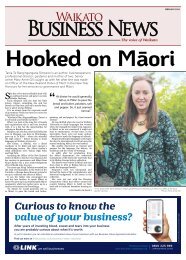Waikato Business News January/February 2021
Waikato Business News has for a quarter of a century been the voice of the region’s business community, a business community with a very real commitment to innovation and an ethos of co-operation.
Waikato Business News has for a quarter of a century been the voice of the region’s business community, a business community with a very real commitment to innovation and an ethos of co-operation.
You also want an ePaper? Increase the reach of your titles
YUMPU automatically turns print PDFs into web optimized ePapers that Google loves.
PR AND COMMUNICATIONS<br />
> BY HEATHER CLAYCOMB<br />
Heather Claycomb is director of HMC Communications, a<br />
Hamilton-based, award-winning public relations agencys.<br />
Let’s get personal<br />
If you want to make one high-impact change this year in the<br />
way you present your organisation, I want to challenge you to<br />
‘get personal.’<br />
While I haven’t done<br />
comprehensive<br />
formal research,<br />
I’ve certainly noticed a general<br />
shift in the type of social<br />
media posts, media stories and<br />
general conversations that are<br />
currently exciting and engaging<br />
people. And that shift is all<br />
about personal, real, emotive<br />
stories.<br />
During times of stress and<br />
upheaval, like we’ve been<br />
through this past year, people<br />
often seek out stories, visual<br />
and auditory content that comforts,<br />
inspires and whisks them<br />
away from the constant negativity<br />
happening around them.<br />
Bringing a bit of<br />
extra personability – and<br />
personality - to your communications<br />
will help increase your<br />
organisation’s reach, create<br />
positive word-of-mouth, gain<br />
fans and generally get those<br />
who matter most talking about<br />
and enjoying their interactions<br />
with you.<br />
So, how can you do this?<br />
Here are five simple ways:<br />
Put your team to work<br />
People want to interact with<br />
other people not a stale, formal<br />
corporate brand. So, why<br />
not put your staff to work? Of<br />
course, you’ll need to do a<br />
bit of training on presentation<br />
style, key messages and general<br />
dos and don’ts but don’t<br />
let the logistics of this hold you<br />
back.<br />
Get your staff to front<br />
videos for social media that<br />
explain a new project or launch<br />
a new product . . . or maybe<br />
use their voices to give life<br />
to a stale, old message. For<br />
instance, how about getting<br />
staff to front safety videos as<br />
part of your health and safety<br />
programme?<br />
You could also broaden the<br />
number of team members who<br />
can speak to media in their<br />
areas of expertise.<br />
What a great way to<br />
demonstrate the depth of your<br />
organisation when there is<br />
more than one leader fronting<br />
stories and issues.<br />
Nix the stock photos<br />
Now, there are certainly times<br />
when stock photos, particularly<br />
for social media posts,<br />
are your only option.<br />
But as much as you possibly<br />
can, use real people in<br />
your photos.<br />
Do a photo shoot with your<br />
staff several times a year,<br />
getting them interacting with<br />
customers and each other in<br />
natural situations. You’ll be<br />
surprised how much use you’ll<br />
get out of one photo shoot.<br />
Another idea is to enlist<br />
customers, partners, suppliers<br />
and others your organisation<br />
regularly interacts with for a<br />
photo shoot.<br />
Having real people in your<br />
visual assets creates a genuine<br />
authenticity that will resonate<br />
with your audience.<br />
Let’s hear your voice<br />
Writing a story from a personal<br />
perspective and using<br />
some team or customer photography<br />
alongside it is great,<br />
but what’s even better is hearing<br />
voices. This might sound<br />
really simplistic but it’s true:<br />
hearing a voice in a video or<br />
audio file can stop people<br />
in their tracks. The content<br />
of what you are saying, of<br />
course, is incredibly important<br />
- you can’t say any old<br />
thing.<br />
But my point is, don’t<br />
always rely on the written<br />
word.<br />
Figure out innovative ways<br />
to bring those words off the<br />
paper and to life through your<br />
people, your customers and<br />
others.<br />
Get out and about<br />
Getting personal requires<br />
being in-person. If your<br />
organisation’s communications<br />
approach has primarily<br />
involved channels such as<br />
social media, publications,<br />
media stories, e-newsletters<br />
and the like then why not consider<br />
channels that get you<br />
out from behind the desk and<br />
talking with those who matter<br />
to your business?<br />
Find ways to add a new<br />
event or two to your communications<br />
approach this year.<br />
Or simply participate in an<br />
event that’s already happening,<br />
for example a conference,<br />
farmer field day or industry<br />
networking event.<br />
If you are a national organisation,<br />
consider a ‘roadshow’<br />
type event that gets you in<br />
front of customers or key<br />
stakeholders in smaller groups<br />
where you can have great discussions<br />
and build relationships.<br />
Pressing the flesh will<br />
reap enormous benefits.<br />
Forget the polish<br />
I’ve seen many organisations<br />
become paralysed by<br />
the worry of having to be too<br />
perfect. While there are certainly<br />
benefits to producing a<br />
beautiful corporate video, for<br />
instance, much of the time an<br />
iPhone selfie edited on some<br />
free video software can resonate<br />
even more with your<br />
audience.<br />
Of course, you need professional<br />
standards, but my<br />
point is don’t analyse the creative<br />
to death. Authentic personability<br />
means there will be<br />
a few rough edges, but we are<br />
all used to that and will give a<br />
bit of leeway.<br />
Reviewing the structure of your business<br />
in the new year<br />
THE BUSINESS EDGE<br />
> BY BRENDA WILLIAMSON<br />
Brenda Williamson runs business advisory service<br />
Brenda Williamson and Associates www.bwa.net.nz<br />
The structure of a business<br />
is key; everything<br />
radiates out from<br />
there. As businesses grow<br />
over time, it’s common for<br />
the structure to become out<br />
of date and lack relevance to<br />
changing needs.<br />
As you return from your<br />
summer holidays, it is a good<br />
opportunity to set your goals<br />
for the year, set your operational<br />
and capital budgets and<br />
take the time to review the<br />
structure.<br />
Ask yourself “is your<br />
business structure still fit for<br />
purpose?”.<br />
As your business grows<br />
and your team expands, you<br />
may decide to introduce extra<br />
levels into the organisational<br />
structure.<br />
The more autonomous<br />
your team is, the flatter the<br />
structure can be.<br />
Try and keep the structure<br />
clean and uncluttered,<br />
wherever possible.<br />
Try to avoid situations<br />
where staff are reporting to<br />
two people; this can lead to<br />
conflict, confusion and a lack<br />
of accountability.<br />
If you don’t already have<br />
an organisational chart, it is<br />
simply a diagram showing<br />
each position, the name of<br />
the team member currently<br />
holding the position and the<br />
reporting lines throughout the<br />
business.<br />
Keep your organisational<br />
chart up to date - it might<br />
seem insignificant to you<br />
as a business owner, but it’s<br />
important that everyone has<br />
a sense of belonging to the<br />
team and an understanding<br />
of where they fit into the<br />
business, including who they<br />
report to and the staff they are<br />
responsible for.<br />
There is a tendency for<br />
small businesses in New Zealand<br />
to build a role around a<br />
person. Let’s just say a particular<br />
person has a unique<br />
skill set and it is in your<br />
interests to utilise that person<br />
to your advantage.<br />
You create a role that<br />
is specific to that person.<br />
Examples would be:<br />
• An engineer who has studied<br />
law<br />
• A builder who has previously<br />
worked as a welder/<br />
fabricator<br />
• An IT expert who has<br />
run their own recruitment<br />
business<br />
• An HR expert who had<br />
years of experience working<br />
in banks<br />
• A warehouse employee<br />
who also has experience<br />
in designing electronic<br />
inventory systems<br />
• A chef who just happens<br />
to have a marketing degree<br />
Their unique skill set and<br />
experience will provide you<br />
with benefits but also creates<br />
a level of risk within your<br />
business.<br />
You need to acknowledge<br />
that when that person<br />
leaves you may end up with<br />
an unusual type of position to<br />
recruit to.<br />
There is no easy way<br />
around this, especially for a<br />
small business where a jackof-all-trades<br />
approach is very<br />
handy.<br />
Also, Kiwis, more than<br />
anyone, are happy to work<br />
‘outside the box’.<br />
By reviewing the structure<br />
and roles within your business,<br />
at least on an annual<br />
basis, this allows you to<br />
identify risk around these<br />
types of roles.<br />
You may flag them and<br />
decide to split or modify<br />
when the opportunity rises,<br />
creating roles that are more<br />
generic and easier to recruit<br />
to. Try to develop a strategy<br />
around what you’ll do when<br />
a “unique” team member<br />
leaves. You may be able to:<br />
• Recruit to the key portion<br />
of the role<br />
• Move part of the role onto<br />
another team member<br />
• Contract out part of<br />
the role (which may<br />
be smaller or specialised<br />
– for instance, IT or<br />
marketing).<br />
If you do change the structure<br />
of your business post-holiday,<br />
be sure to communicate<br />
this to your team. Of course,<br />
you will know what you are<br />
doing but let the team know<br />
what your intentions are!


















